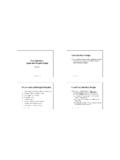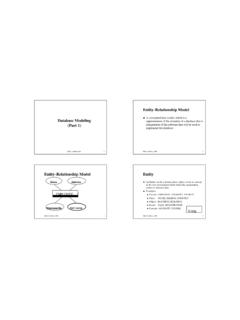Transcription of Four power worldwide changes have altered the …
1 M7011 Peter Lo 20051 The Information Systems RevolutionM7011 Peter Lo 20052 Why Information Systems? Four power worldwide changes have altered the environment of business emergence of Global Economy Transformation of Industrial Economies Transformation of Business Enterprise emergence of the digital FirmM7011 Peter Lo 20053 emergence of Global Economy Globalization of the world s industrial economies greatly enhances the value of information to the firm and offers new opportunities to businesses. Information systems provide the communication and analytic power that firms need for conducting trade and managing businesses on a global scale. Controlling the far-flung global corporation (communicating with distributors and suppliers, operating 7x24 in a different national environments, servicing local and international reporting needs) is a major business challenge that requires powerful information system Peter Lo 20054 emergence of Global Economy Globalization and information technology also bring new threats to domestic business firms: because global communication and management systems, customers now can shop in a worldwide marketplace, obtaining price and quality information reliably, 24 hours a day.
2 Competition forces firms to play in open, unprotected worldwide markets. To become effective and profitable participants in international markets, firms need powerful information and communication Peter Lo 20055 Transformation of Industrial Economies The knowledge and information revolution began at the turn of the 20thcentury has gradually accelerated. Today, most people no longer work on farms or in factories, but instead are found in sales, education, healthcare, banks, insurance firms and law firms. Knowledge and information are becoming the foundation for many new services and products. Intensification of knowledge utilization in the production of traditional products has increased well. automobile industryM7011 Peter Lo 20056 Transformation of Industrial Economies In a knowledge and information based economy, information technology and systems are importance. Knowledge based products and services of great economic value are based on new information technologies.
3 Information and the technology become critical, strategic assets for business firms and their managers. Information systems are needed to optimize the flow of management and knowledge within the organization and to help management maximize the firm s knowledge resources. Because the productivity of employees will depend on the quality of the system serving them, management decisions about information technology are critically important to the prosperity and survival of a Peter Lo 20057 Transformation of Business Enterprise The traditional business firm was hierarchical, centralized, structured arrangement of specialists that typically relies on fixed set of Standard Operation Procedures(SOP) to deliver a mass-produced product or service. The new style of business firm is a flattened, decentralized, flexible arrangement of generalists who rely on nearly instant information to deliver mass-customized products and services uniquely suited for specific markets and Peter Lo 20058 Transformation of Business Enterprise The traditional management group relied on formal plans, a rigid division of labor, formal rules, and appeals to loyalty to ensure the proper operation of a firm.
4 The new manager relies on informal commitments and networks to establish goals, a flexible arrangement of teams and individuals working in task forces, a customer orientation to achieve coordination among employees and appeals to professionalism and knowledge to ensure proper operation of the firm. Information technology makes this style of management possible. M7011 Peter Lo 20059 emergence of the digital Firm Digitally-enabled relationships with customers, suppliers, and employees Core business processes accomplished via digital networks digital management of key corporate assets Rapid sensing and responding to environmental changesM7011 Peter Lo 200510 Four Major Systems Defining the digital Firm Supply Chain Management (SCM) Systems Customer Relationship Management (CRM) Systems Enterprise Resource Planning (ERP) Systems Knowledge Management (KM) SystemsM7011 Peter Lo 200511 What is an Information System? An Information System (IS) is a set of interrelated components that collect (or retrieve), process, store, and distribute information to support decision-making and control in an organization.
5 HardwarepeopledataproceduressoftwareM701 1 Peter Lo 200512 Data Data is streams of raw facts representing events occurring in organizations or the physical environment before they have been organized and arranged into a form that people can understand and Peter Lo 200513 Information Information is data that has been changed into useful and meaningful form to human being. The task of changing data into information is called Peter Lo 200514 Activities of an Information System An Information System contains information about an organization and its surrounding environment . Three basic activities (Input, Processingand Output) produce the information organization need. InputProcessOutputFeedbackcontrolstoreM7 011 Peter Lo 200515 Basic Activities Input the capture or collection of raw data from within the organization or from external environment for processing in an Information System. Output the distribution of processed information to the people who will use it or to the activities for which it will be used.
6 Processing the conversion, manipulation, and analysis of raw input into a form that is more meaningful to human being. Feedback output that is returned to the appropriate members of the organization to help them to evaluate or correct Peter Lo 200516 Functions of an Information SystemM7011 Peter Lo 200517 Computer-based Information Systems (CBIS) Computer-based Information Systems(CBIS) are information systems that rely on computer hardware and software for processing and disseminating information. A Formal Systemis a system resting on accepted and fixed definitions of data and procedures, operating with predefined values. Informal information systems rely on unstated rules of behavior. There is no agreement on what is information, or on how it will be stored or processed. Formal information systems can either be computer-based or manual. Manual systems use paper-and-pencil Peter Lo 200518 Business Perspective on Information Systems Form a business perspective, an Information System is an organizational and management solution based on Information Technology, to a challenge posed by the environment .
7 Information Systems Literacy: Broad-based understanding of Information System that includes behavioral knowledge about organizations and individuals using Information Systems and technical knowledge about computers. Computer Literacy: Knowledge about Information Technology, focusing on understanding how computer-based technologies workM7011 Peter Lo 200519 Business Perspective on Information SystemsORGANIZATIONSTECHNOLOGYMANAGEMENT INFORMATIONSYSTEMSM7011 Peter Lo 200520 Major Business Functions Sales and Marketing Selling the organization s products and services Manufacturing Producing products and services Finance Managing the organization s financial assets (cash, stocks, bonds, etc.) Accounting Maintaining the organization s financial records (receipt, disbursements, paychecks, etc.) Human Resources Attracting, developing and maintaining the organization s labor force; maintaining employee Peter Lo 200521 Key Elements of Organizations Information systems are a part of organizations.
8 The key elements of an organization are: People: Managers, knowledge workers, data workers, production or service workers Structure: Organization chart, groups of specialists, products, geography Operating Procedures: Standard operating procedures (SOP, rules for action) Politics: power to persuade, get things done Culture: Customs of behaviorM7011 Peter Lo 200522 Standard Operating Procedures (SOP) Standard Operating Procedures (SOP) are formal rules for accomplishing tasks that have been developed to cope with expected situations. These rules guide employees in a variety of procedures, from writing an invoice to responding to complaining customers. Most procedures are formal writing and written down, but others are informal work practices. Many of a firms SOP s are incorporated into information Peter Lo 200523 People in Organization In additional to manager, companies also require Knowledge Workers: people such as engineers or architects who design products and services and create new knowledge for the organizations.
9 Data Workers: people such as secretaries, bookkeepers or clerks who process the organization s paperwork. Production and Service Workers: people such as machinists, assemblers or packers who actually produce the products and services of the Peter Lo 200524 Management Managers perceive business challenges in the environment . They set the organizational strategy for responding and allocate the human and financial resources to achieve the strategy and coordinate the work. They must exercise responsible leadership. Management s job is to formulate action plans to solve organizational problems. They must also create new products and services and even re-create the organization from time to time. A substantial part of management is creative work driven by new knowledge and information. IT can play a powerful role in redirecting and redesigning the Peter Lo 200525 Management Managerial roles and decisions vary at different levels of organization: Senior managers make long-range strategic decision making about products and services.
10 Middle managers carry out the programs and plans for senior management. Operational managers are responsible for monitoring the firm s daily activities. All levels of management are expected to be creative, to develop novel solutions to a broad range of problems. Each level of management has different information needs and information system Peter Lo 200526 Technology Information Technology is one of many tools available for managers for coping with changes : Computer Hardware Computer Software Storage Communications Technology NetworksM7011 Peter Lo 200527 Technology Computer Hardware Physical equipment used for input, processing and output activities in an Information Peter Lo 200528 Technology Computer Software The detailed preprogrammed instructions that control and coordinate the hardware components in an Information Peter Lo 200529 Technology Storage Physical media for storing data (such as magnetic or optical disk or tape)













